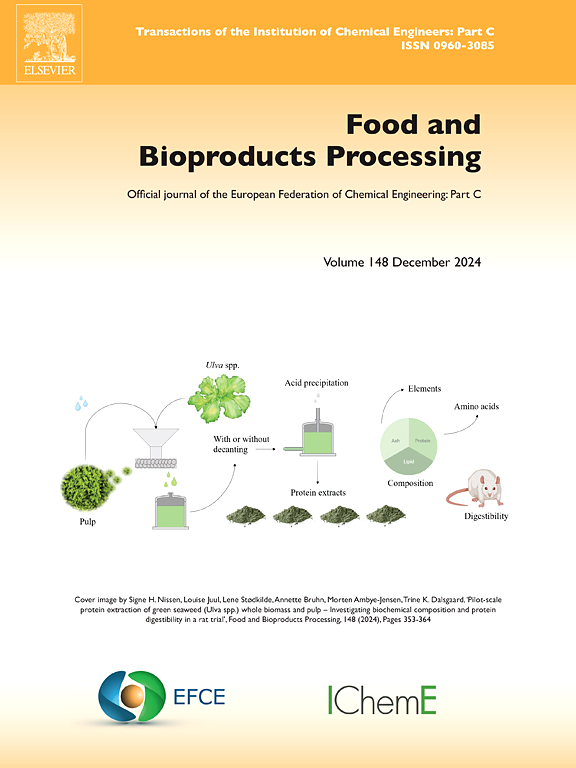用于肉桂精油分馏的真空批次精馏塔的实验研究和工艺建模
IF 3.5
2区 农林科学
Q2 BIOTECHNOLOGY & APPLIED MICROBIOLOGY
引用次数: 0
摘要
肉桂油中含有多种具有经济价值的化合物,包括反式肉桂醛、苯甲醛和香豆素。分离出更多的成分可以提高利润率,并鼓励进一步使用这些成分。然而,对分离高纯度产品所需的温度和压力条件缺乏研究。本研究利用实验数据开发并验证了批量精馏塔模型。该模型根据温度确定了每个产品段的组分纯度,并将其放大到 1000 公斤/批次,以确定最佳条件。在这项研究中,对四个产品段进行了实验分馏,反式肉桂醛段的纯度达到 96.31 wt%。计算结果与操作温度和产品成分的实验数据一致。通过工艺模型,确定了分离五种高纯度产品段的最佳条件。结果表明,在 124°C、0.2 atm 的压力下可分离出浓度为 99 wt%的苯甲醛。在 141°C 的温度下可分离出含量为 99 wt%的水杨醛。纯度为 99 wt%的反式肉桂醛在 190.5°C 下进行了精馏,浓度为 99 % 的甲氧基肉桂醛在 220°C 下得到。在最佳条件下,苯甲醛、反式肉桂醛和甲氧基肉桂醛的纯度均超过 99%,回收率分别为 90%、86% 和 78%。这项研究可应用于肉桂和其他精油(如茴香油和松油)精油精馏系统的设计、操作和优化。本文章由计算机程序翻译,如有差异,请以英文原文为准。
Experimental study and process modeling of vacuum batch rectification column for cinnamon essential oil fractionation
Cinnamon oil contains several economically valuable compounds, including trans-cinnamaldehyde, benzaldehyde, and coumarin. Separating more components boosts profitability and encourages their further use. However, there is a lack of research on the temperature and pressure conditions required for separating high-purity products. This study developed and validated a batch rectification column model using experimental data. The model identified component purity for each product segment based on temperature and was scaled up to 1000 kg/batch to determine optimal conditions. In this study, four product segments were fractionated experimentally, with the trans-cinnamaldehyde segment achieving a purity of 96.31 wt%. The calculated results aligned with the experimental data on operating temperatures and product compositions. The optimal conditions for separating five product segments with high purity were identified through the process model. It was determined that benzaldehyde with a concentration of 99 wt% was separated at 124°C under a pressure of 0.2 atm. Salicylicaldehyde with a composition of 99 wt% was obtained at 141°C. Trans-cinnamaldehyde with a purity of 99 wt% was rectified at 190.5°C, and methoxy cinnamaldehyde with a concentration of 99 % was obtained at 220°C. At optimal conditions, Benzaldehyde, Trans-Cinnamaldehyde, and Methoxy cinnamaldehyde have the purity all over 99 % with the recovery of 90 %, 86 %, and 78 %, respectively. This research can apply for the design, operation, and optimization of essential oil rectification systems for cinnamon and other oils, such as anise and pine.
求助全文
通过发布文献求助,成功后即可免费获取论文全文。
去求助
来源期刊

Food and Bioproducts Processing
工程技术-工程:化工
CiteScore
9.70
自引率
4.30%
发文量
115
审稿时长
24 days
期刊介绍:
Official Journal of the European Federation of Chemical Engineering:
Part C
FBP aims to be the principal international journal for publication of high quality, original papers in the branches of engineering and science dedicated to the safe processing of biological products. It is the only journal to exploit the synergy between biotechnology, bioprocessing and food engineering.
Papers showing how research results can be used in engineering design, and accounts of experimental or theoretical research work bringing new perspectives to established principles, highlighting unsolved problems or indicating directions for future research, are particularly welcome. Contributions that deal with new developments in equipment or processes and that can be given quantitative expression are encouraged. The journal is especially interested in papers that extend the boundaries of food and bioproducts processing.
The journal has a strong emphasis on the interface between engineering and food or bioproducts. Papers that are not likely to be published are those:
• Primarily concerned with food formulation
• That use experimental design techniques to obtain response surfaces but gain little insight from them
• That are empirical and ignore established mechanistic models, e.g., empirical drying curves
• That are primarily concerned about sensory evaluation and colour
• Concern the extraction, encapsulation and/or antioxidant activity of a specific biological material without providing insight that could be applied to a similar but different material,
• Containing only chemical analyses of biological materials.
 求助内容:
求助内容: 应助结果提醒方式:
应助结果提醒方式:


